Robust Orientation Estimation from MEMS Magnetic, Angular Rate, and Gravity (MARG) Modules for Human–Computer Interaction
Abstract
1. Introduction
1.1. Need for a Different Approach
1.2. Prediction–Correction of MARG Orientation
1.3. Scope of Our Approach to Prediction–Correction MARG Orientation for HCI
- (a)
- As we expect the MARG to be affixed, in one way or another, to the hand of a human computer user, we can expect that there will be intervals in which the MARG will be static (or very close to it), occurring frequently.
- (b)
- The overall travel of a MARG in any particular use run will be constrained to the scale of meters. This, in fact, implies that objects around the MARG (and, in particular, large ferromagnetic objects) will remain in static or slowly moving relative positions with respect to the MARG.
1.4. New View of the Information Sources Onboard a MARG Module
1.5. Estimation of Orientation Differences
1.5.1. Inferring Orientation from Gyroscope Signals
1.5.2. Inferring Orientation Information from Accelerometer Measurements
1.5.3. Inferring Orientation Information from Magnetometer Measurements
1.6. Relevant Previous Work
2. Materials and Methods
2.1. GMVDK Algorithm for MARG Orientation Estimation
- (a)
- Create one orientation estimate derived from gyroscope measurements, qG, and two estimates that are independently corrected with information from the accelerometer, qGA, and the magnetometer, qGM.
- (b)
- Scale down the strength of the accelerometer- and magnetometer-based corrections by interpolating from qG to qGA and from qG to qGM using “spherical linear interpolation” (SLERP), operations [40] controlled by the corresponding trustworthiness parameters α and μ. This defines the “scaled” corrected quaternions qSA and qSM, respectively.
- (c)
- Finally, fuse qSA and qSM, via a “second tier” of SLERP interpolation, to define a final MARG orientation estimation quaternion, qOUT, which uses information from the 3 sources available, but would not contain strong corrections directed by the accelerometer or the magnetometer if their preconditions are not met.
2.2. Computation of the Trustworthiness Parameters α and μ
2.2.1. Original Formulations
2.2.2. New Computation of Magnetometer Trustworthiness, μK, without Position Information (GMVDK)
2.2.3. Pseudocode for Parameter Computation and Parameter Sensitivities
3. Results
3.1. Experimental Protocol
3.2. Orientation Estimates Obtained from Different Approaches
3.3. Additional Evaluations of GMVDK Performance
4. Discussion
5. Conclusions
Author Contributions
Funding
Data Availability Statement
Conflicts of Interest
Appendix A. Specifications of the 3-Space Micro USB MARG Module from Yost Labs
| Parameter | Specification |
|---|---|
| Part number | TSS-MUSB (8G Accelerometer) |
| TSS-MUSB-HH (24G Accelerometer) | |
| TSS-MUSB-H3 (400G Accelerometer) | |
| Dimensions | 23 mm × 23 mm × 2.2 mm (0.9 × 0.9 × 0.086 in.) |
| Weight | 1.3 g (0.0458 oz) |
| Supply voltage | +3.3 v ~ +6.0 v |
| Power consumption | 45 mA @ 5 v |
| Communication interfaces | USB 2.0, asynchronous serial |
| Filter update rate | up to 250 Hz with Kalman AHRS (higher with oversampling) |
| up to 850 Hz with QCOMP AHRS (higher with oversampling) | |
| up to 1000 Hz in IMU mode | |
| Orientation output | absolute and relative quaternion, Euler angles, axis angle, rotation matrix, two vector |
| Other output | raw sensor data, normalized sensor data, calibrated sensor data, temperature |
| Serial baud rate | 1200~921,600 selectable, default: 115,200 |
| Shock survivability | 5000 g |
| Temperature range | −40~85 °C (−40~185 F) |
| Parameter | Specification |
|---|---|
| Orientation range | 360° about all axes |
| Orientation accuracy | ±1° for dynamic conditions and all orientations |
| Orientation resolution | <0.08° |
| Orientation repeatability | 0.085° for all orientations |
| Accelerometer scale | ±2 g/±4 g/±8 g selectable for standard models |
| ±6 g/±12 g/±24 g selectable for HH models | |
| ±100 g/±200 g/±400 g selectable for H3 models | |
| Accelerometer resolution | 14 bit, 12 bit (HH), 12 bit (H3) |
| Accelerometer noise density | 99 µg/√Hz, 650 µg/√Hz (HH), 15 mg/√Hz (H3) |
| Accelerometer sensitivity | 0.00024 g/digit–0.00096 g/digit |
| 0.003 g/digit–0.012/digit (HH) | |
| 0.049 g/digit–0.195 g/digit (H3) | |
| Accelerometer temperature sensitivity | ±0.008%/°C, ±0.01%/°C (HH, H3) |
| Gyro scale | ±250/±500/±1000/±2000°/s selectable |
| Gyro resolution | 16 bit |
| Gyro noise density | 0.009°/s/√Hz |
| Gyro bias stability @ 25 °C | 2.5°/h average for all axes |
| Gyro sensitivity | 0.00833°/s/digit for ±250°/s |
| 0.06667°/s/digit for ±2000°/s | |
| Gyro non-linearity | 0.2% full-scale |
| Gyro temperature sensitivity | ±0.03%/°C |
| Compass scale | ±0.88 Ga to ±8.1 Ga selectable (±1.3 Ga default) |
| Compass resolution | 12 bit |
| Compass sensitivity | 0.73 mGa/digit |
| Compass non-linearity | 0.1% full-scale |
Appendix B. Pseudo-Code for Computation of Trustworthiness Parameters and Sensitivity Analysis
Appendix B.1. Pseudocode for Computation of the Accelerometer Trustworthiness Parameter Alpha
- Set value of SlopeAlpha (Suggested 1.0)
- Read (called “Confidence Factor” in the 3-Space module) from MARG
- alpha1 = (Stillness SlopeAlpha × Stillness) + 1 − SlopeAlpha
- alpha = [alpha1 + abs(alpha1)]/2
Appendix B.2. Pseudocode for Computation of the Magnetometer Trustworthiness Parameter MUK
- Set value of SlopeMuk (Suggested 1.5)
- Read current magnetometer values, m0, from MARG
- Compute the mapping of current magnetometer readings, m0, to the inertial frame:m0i = qOUT ⊗ m0 ⊗ qOUT*
- Compute the cosine of the angle lambda between moi (obtained in 3.) and the initial magnetometer reading, at startup, Minit:magnitude_m0i = norm(m0i)
magnitude_Minit = norm(Minit)
cos_lambda = dot(m0i, Minit)/(magnitude_m0i × magnitude_Minit) - lambda = acos(cos_lambda)
- MuKA = 1 − (SlopeMuk × lambda)
- penalty_MuKM = (magnitude_moi/magnitude_Minit) × lambda
- MuKM = 1 − penalty_MuKM
- Mu1 = [MuKA + MukM)/2
- Mu2 = min(current and past Mu1 values in the last 0.4 s)
- MUK = Mu2 × alpha
- SlopeMuk, magnitude_m0i, magnitude_Minit, cos_lambda, lambda, MuKA, penalty_MuKM, MuKM, Mu1, Mu2, and MUK are all scalar variables.
- m0, m0i, and Minit are 3D vectors. qOUT and its conjugate qOUT* are quaternions.
- ⊗ represents quaternion product; norm( ) is the magnitude of a 3D vector; dot( ) is the dot product of two 3D vectors; abs( ) is the absolute value of a scalar; × is the product of scalars.
Appendix B.3. Sensitivity of the GMVDK Performance to Values of SlopeAlpha and SlopeMuk

| SlopeAlpha | 0.25 | 0.50 | 0.75 | 1.00 | 1.25 | 1.50 | 1.75 |
| RMSE_from_GMVDK (°) | 9.451 | 9.821 | 9.995 | 9.843 | 9.574 | 9.525 | 9.566 |
| SlopeAlpha | 75% | 100% | 125% |
| RMSE_from_GMVDK | 101.55% | 100% | 97.27% |
| SlopeMuk | 0.75 | 1.00 | 1.25 | 1.50 | 1.75 | 2.00 | 2.25 |
| RMSE_from_GMVDK (°) | 18.691 | 10.523 | 10.059 | 9.843 | 9.730 | 9.686 | 9.654 |
| SlopeMuk | 83.33% | 100% | 116.66% |
| RMSE_from_GMVDK | 102.20% | 100% | 98.86% |
Appendix C. GMVDK Performance at Varying Levels and Directions of Magnetic Disruption
Appendix C.1. Magnetic Disruptor Not Placed at Location B, but 15 cm South from Location B
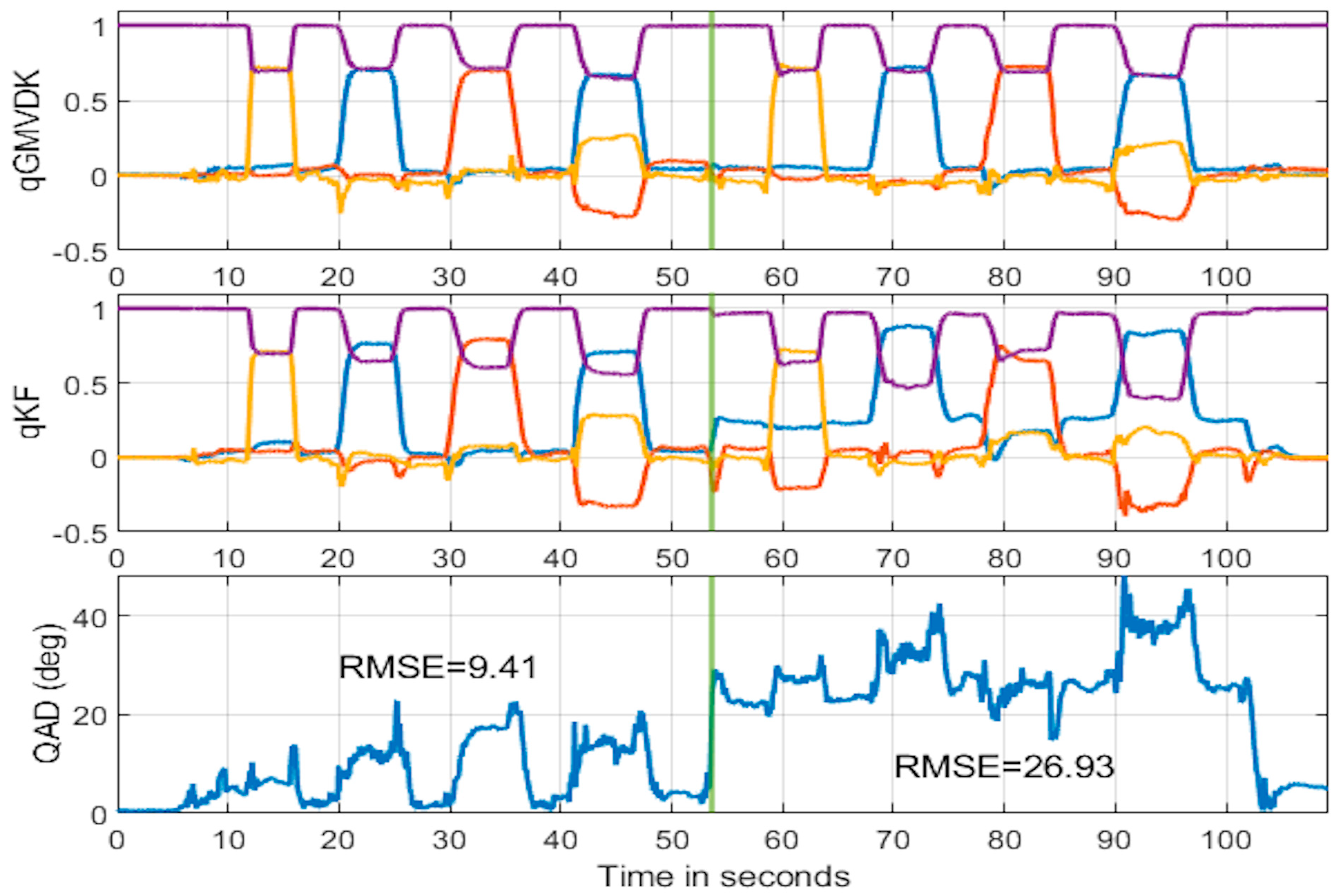
Appendix C.2. Magnetic Disruptor Not Placed at Location B, but 15 cm North from Location B
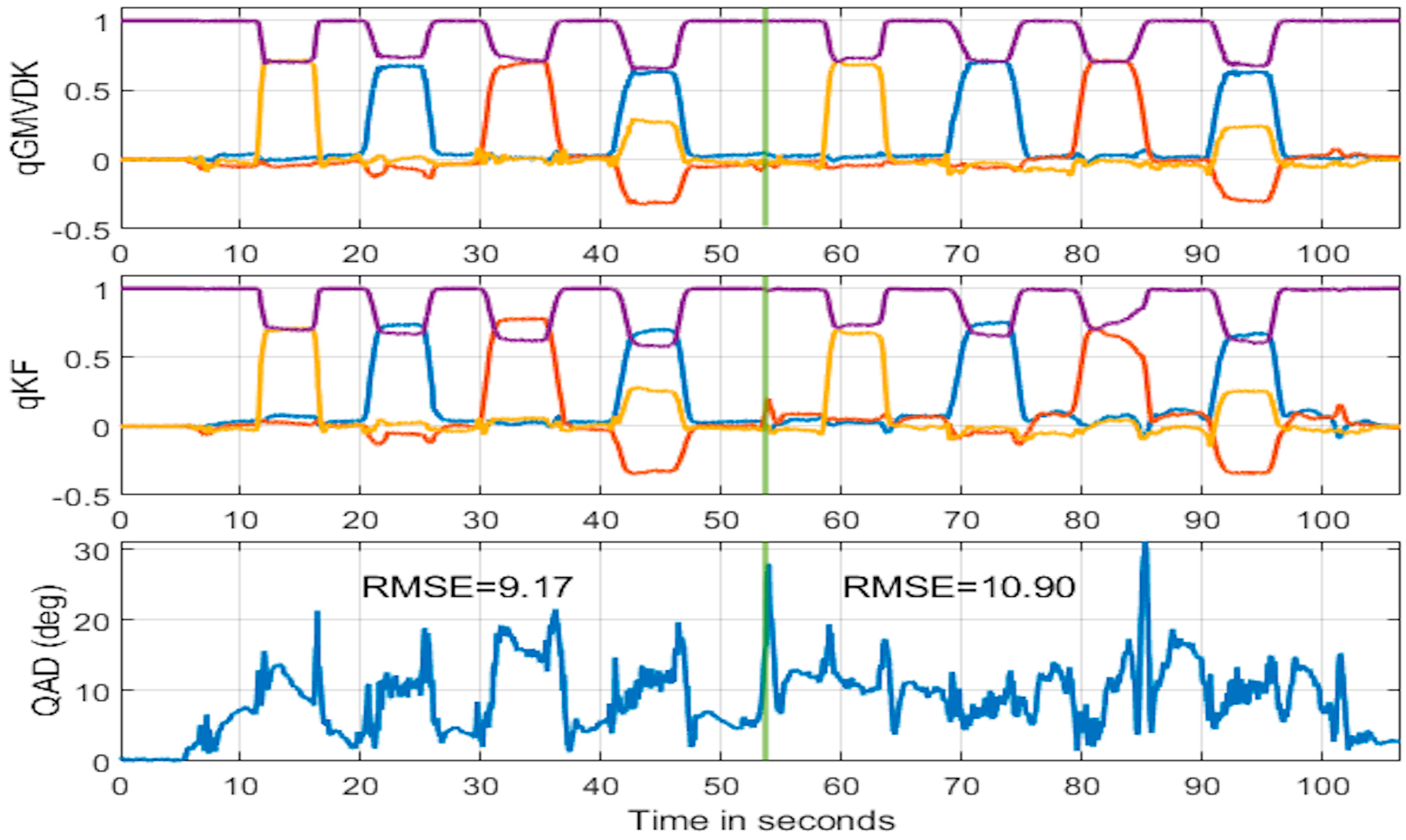
Appendix D. H-B-A-H Route Testing
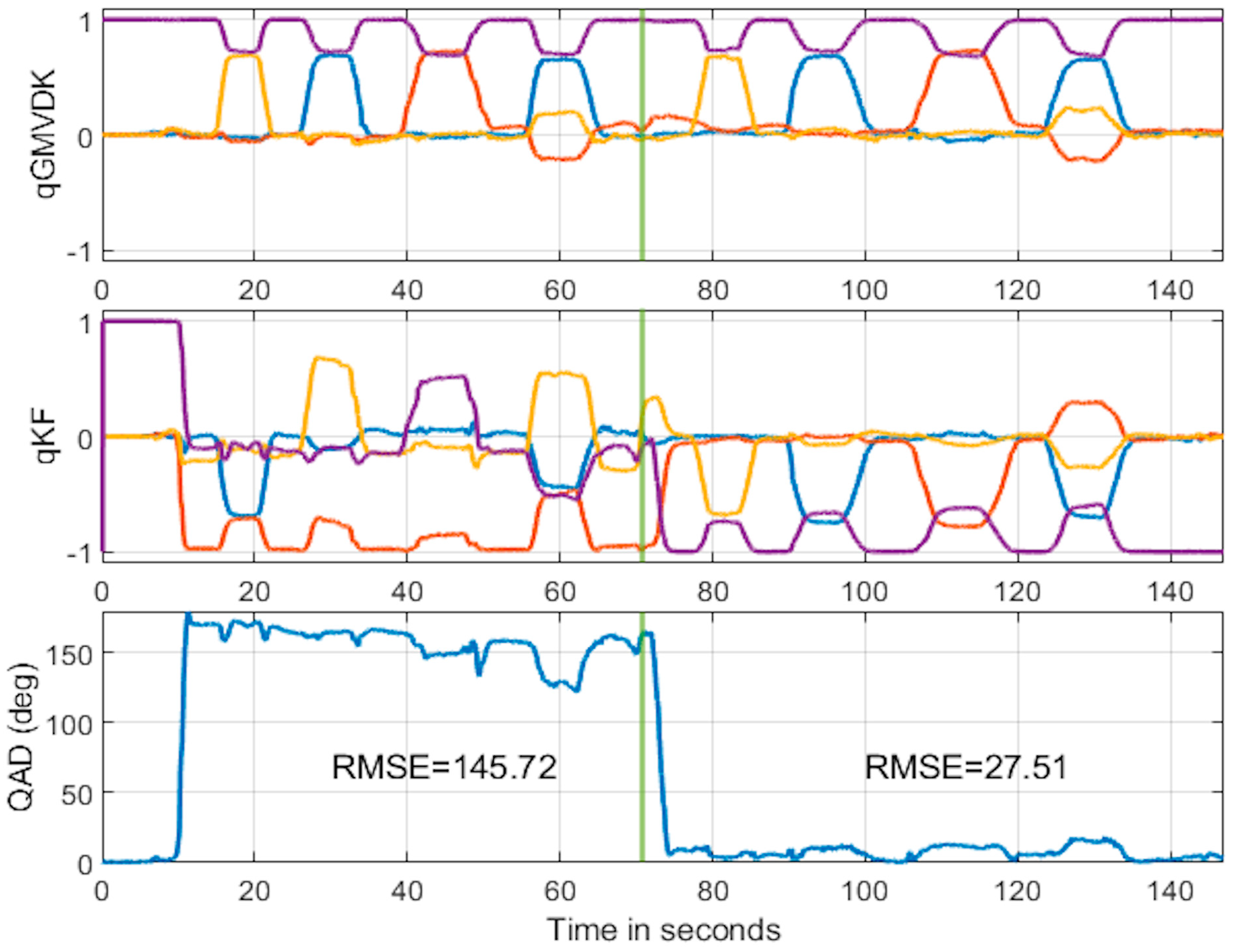
References
- Lee, I.; Yoon, G.H.; Park, J.; Seok, S.; Chun, K.; Lee, K.-I. Development and analysis of the vertical capacitive accelerometer. Sens. Actuators A Phys. 2005, 119, 8–18. [Google Scholar] [CrossRef]
- Roylance, L.M.; Angell, J.B. A batch-fabricated silicon accelerometer. IEEE Trans. Electron Devices 1979, 26, 1911–1917. [Google Scholar] [CrossRef]
- Johnson, R.C. 3-Axis MEMs gyro chip debuts. EE Times, 26 October 2009. [Google Scholar]
- Titterton, D.H.; Weston, J.L.; Institution of Electrical Engineers. Strapdown Inertial Navigation Technology; Institution of Electrical Engineers: Stevenage, UK, 2004; p. xvii. 558p. [Google Scholar]
- Savage, P.G. Strapdown Analytics; Strapdown Associates: Maple Plain, MN, USA, 2000. [Google Scholar]
- Ignagni, M.B. Strapdown Navigation Systems: Theory and Application; Champlain Press: Minneapolis, MN, USA, 2018; 570p. [Google Scholar]
- Foxlin, E. Motion Tracking Requirements and Technologies. In Handbook of Virtual Environments, Design, Implementation, and Applications; Stanney, K.M., Ed.; Lawrence Earlbaum Associates: Mahwah, NJ, USA, 2002. [Google Scholar]
- Woodman, O.J. An Introduction to Inertial Navigation; Technical Report No. 696, UCAM-CL-TR-696, ISSN 1476-2980; University of Cambridge: Cambridge, UK, 2007; ISSN 1476-2980. [Google Scholar]
- KVHIndustries. Guide to Comparing Gyro and IMU Technologies—Micro-Electro-Mechanical Systems and Fiber Optic Gyros; KVHIndustries Inc.: Middletown, RI, USA, 2014; p. 10. [Google Scholar]
- Wu, H.; Zheng, X.; Shen, Y.; Wang, X.; Jin, Z.; Ma, Z. A sub-0.1°/h bias-instability MEMS gyroscope using resonant constant-frequency driving technique. In Proceedings of the 2021 IEEE Sensors, Sydney, Australia, 31 October–3 November 2021; pp. 1–4. [Google Scholar]
- Wu, H.; Zheng, X.; Wang, X.; Shen, Y.; Ma, Z.; Jin, Z. A 0.09°/h bias-instability MEMS gyroscope working with a fixed resonance frequency. IEEE Sens. J. 2021, 21, 23787–23798. [Google Scholar] [CrossRef]
- Bu, F.; Guo, S.; Fan, B.; Wang, Y. Effect of quadrature control mode on ZRO drift of MEMS gyroscope and online compensation method. Micromachines 2022, 13, 419. [Google Scholar] [CrossRef] [PubMed]
- TRONICS-TDK. GYPRO4300–High Stability Closed-Loop MEMS Gyroscope with Digital Interface Datasheet. 2021. Available online: https://product.tdk.com/system/files/dam/doc/product/sensor/mortion-inertial/gyro/data_sheet/datasheet_gypro3300.pdf (accessed on 6 April 2024).
- BOSCH. BMI088 6-Axis Motion Tracking for High-Performance Applications Data Sheet. 2018. Available online: https://www.mouser.com/datasheet/2/783/BST_BMI088_DS001-1509549.pdf (accessed on 6 April 2024).
- InvenSense. MPU-9150 Product Specification Revision 4.3; Technical Description of the MPU-9150 Chip; InvenSense Document Number PS-MPU-9150A-00; InvenSense Inc.: Sunnyvale, CA, USA, 2013; 50p. [Google Scholar]
- Kalman, R.E. A new approach to linear filtering and prediction problems. J. Basic Eng. 1960, 82, 35–45. [Google Scholar] [CrossRef]
- Barreto, A.; Adjouadi, M.; Ortega, F.R.; O-larnnithipong, N. Intuitive Understanding of Kalman Filtering with MATLAB, 1st ed.; CRC Press: Boca Raton, FL, USA, 2020; p. 230. [Google Scholar]
- Kuipers, J.B. Quaternions and Rotation Sequences: A Primer with Applications to Orbits, Aerospace, and Virtual Reality; Princeton University Press: Princeton, NJ, USA, 1999; 400p. [Google Scholar]
- Hanson, A. Visualizing Quaternions; Morgan Kaufmann/Elsevier Science Distributor: San Francisco, CA, USA; Amsterdam, The Netherlands; Boston, UK, 2006; 536p. [Google Scholar]
- Vince, J. Quaternions for Computer Graphics; Springer: London UK; New York, NY, USA, 2011; 154p. [Google Scholar]
- Aggarwal, P. MEMS-Based Integrated Navigation; Artech House: Boston, MA, USA; London, UK, 2010; 197p. [Google Scholar]
- Aggarwal, P.; El-Sheimy, N.; Niu, X.; Syed, Z. A Standard Testing and Calibration Procedure for Low Cost MEMS Inertial Sensors and Units. J. Navig. 2008, 61, 323–336. [Google Scholar] [CrossRef]
- Bar-Itzhack, I.y.; Oshman, Y. Attitude Determination from Vector Observations: Quaternion Estimation. IEEE Trans. Aerosp. Electron. Syst. 1985, AES-21, 128–136. [Google Scholar] [CrossRef]
- Shuster, M.D.; Oh, S.D. Three-axis attitude determination from vector observations. J. Guid. Control Dyn. 1981, 4, 70–77. [Google Scholar] [CrossRef]
- Ratchatanantakit, N.; O-larnnithipong, N.; Barreto, A.; Tangnimitchok, S. Consistency Study of 3D Magnetic Vectors in an Office Environment for IMU-Based Hand Tracking Input Development; Lecture Notes in Computer Science (including subseries Lecture Notes in Artificial Intelligence and Lecture Notes in Bioinformatics); 11567 LNCS; Springer: Cham, Switzerland, 2019; pp. 377–387. [Google Scholar] [CrossRef]
- de Vries, W.H.K.; Veeger, H.E.J.; Baten, C.T.M.; van der Helm, F.C.T. Magnetic distortion in motion labs, implications for validating inertial magnetic sensors. Gait Posture 2009, 29, 535–541. [Google Scholar] [CrossRef]
- Coley, B.; Jolles, B.M.; Farron, A.; Bourgeois, A.; Nussbaumer, F.; Pichonnaz, C.; Aminian, K. Outcome evaluation in shoulder surgery using 3D kinematics sensors. Gait Posture 2007, 25, 523–532. [Google Scholar] [CrossRef] [PubMed]
- Zijlstra, W.; Bisseling, R. Estimation of hip abduction moment based on body fixed sensors. Clin. Biomech. 2004, 19, 819–827. [Google Scholar] [CrossRef] [PubMed]
- Kortier, H.; Schepers, H.M.; Sluiter, V.I.; Veltink, P.H. Ambulatory Assesment of Hand Kinematics, using an instrumented glove. In Proceedings of the 12th International Symposium on 3-D Analysis of Human Movement, 3DMA 2012: Technology & Treatment, Bologna, Italy, 18–20 July 2012; pp. 15–18. [Google Scholar]
- Kortier, H.G.; Sluiter, V.I.; Roetenberg, D.; Veltink, P.H. Assessment of hand kinematics using inertial and magnetic sensors. J. Neuroeng. Rehabil. 2014, 11, 70. [Google Scholar] [CrossRef] [PubMed]
- Noort, J.V.D.; Dijk, K.V.; Kortier, H.; Beek, N.V.; Verhagen, R.; Bour, L.; Veltink, P. Applications of the PowerGlove for Measurement of Finger Kinematics. In Proceedings of the 2014 11th International Conference on Wearable and Implantable Body Sensor Networks Workshops, Zurich, Switzerland, 16–19 June 2014; pp. 6–10. [Google Scholar]
- Lin, B.S.; Lee, I.J.; Chen, J.L. Novel Assembled Sensorized Glove Platform for Comprehensive Hand Function Assessment by Using Inertial Sensors and Force Sensing Resistors. IEEE Sens. J. 2020, 20, 3379–3389. [Google Scholar] [CrossRef]
- Nazarahari, M.; Rouhani, H. 40 years of sensor fusion for orientation tracking via magnetic and inertial measurement units: Methods, lessons learned, and future challenges. Inf. Fusion 2021, 68, 67–84. [Google Scholar] [CrossRef]
- Nazarahari, M.; Rouhani, H. Sensor fusion algorithms for orientation tracking via magnetic and inertial measurement units: An experimental comparison survey. Inf. Fusion 2021, 76, 8–23. [Google Scholar] [CrossRef]
- McGee, L.A. Discovery of the Kalman Filter as a Practical Tool for Aerospace and Industry; National Aeronautics and Space Administration: Washington, DC, USA, 1985; Volume 86847. [Google Scholar]
- Grewal, M.S.; Andrews, A.P. Applications of Kalman Filtering in Aerospace 1960 to the Present [Historical Perspectives]. IEEE Control Syst. Mag. 2010, 30, 69–78. [Google Scholar] [CrossRef]
- Himberg, H.; Motai, Y.; Barrios, C. R-adaptive kalman filtering approach to estimate head orientation for driving simulator. In Proceedings of the 2006 IEEE Intelligent Transportation Systems Conference, Toronto, ON, Canada, 17–20 September 2006; IEEE: New York, NY, USA, 2006. [Google Scholar]
- Valenti, R.G.; Dryanovski, I.; Xiao, J. A linear Kalman filter for MARG orientation estimation using the algebraic quaternion algorithm. IEEE Trans. Instrum. Meas. 2015, 65, 467–481. [Google Scholar] [CrossRef]
- Xiaoping, Y.; Bachmann, E.R.; McGhee, R. A Simplified Quaternion-Based Algorithm for Orientation Estimation From Earth Gravity and Magnetic Field Measurements. Instrum. Meas. IEEE Trans. 2008, 57, 638–650. [Google Scholar] [CrossRef]
- Shoemake, K. Animating rotation with quaternion curves. SIGGRAPH Comput. Graph. 1985, 19, 245–254. [Google Scholar] [CrossRef]
- larnnithipong, N. Hand Motion Tracking System Using Inertial Measurement Units and Infrared Cameras. Ph.D. Thesis, Florida International University, Miami, FL, USA, 2018. [Google Scholar]
- Ratchatanantakit, N.; O-larnnithipong, N.; Sonchan, P.; Adjouadi, M.; Barreto, A. A sensor fusion approach to MARG module orientation estimation for a real-time hand tracking application. Inf. Fusion 2023, 90, 298–315. [Google Scholar] [CrossRef]
- YostLabs. 3-Space Sensor Miniature Attitude & Heading Reference System with Pedestrian Tracking User’s Manual; Manual for the 3Space Family of Modules; Yost Labs: Portsmouth, OH, USA, 2017; 81p, Available online: https://yostlabs.com/wp-content/uploads/pdf/3-Space-Sensor-Users-Manual-3.pdf (accessed on 27 March 2024).
- Ratchatanantakit, N.; O-larnnithipong, N.; Sonchan, P.; Adjouadi, M.; Barreto, A. Live Demonstration: Double SLERP Gravity-Magnetic Vector (GMV-D) orientation correction in a MARG sensor. In Proceedings of the 2021 IEEE Sensors, Sydney, Australia, 31 October–3 November 2021. [Google Scholar]
- Ratchatanantakit, N.; O-larnnithipong, N.; Sonchan, P.; Adjouadi, M.; Barreto, A. Statistical Evaluation of Orientation Correction Algorithms in a Real-Time Hand Tracking Application for Computer Interaction; Springer: Cham, Switzerland, 2022; pp. 92–108. [Google Scholar]
- Grewal, M.S.; Andrews, A.P.; Bartone, C. Global Navigation Satellite Systems, Inertial Navigation, and Integration, 4th ed.; John Wiley & Sons, Inc.: Hoboken, NJ, USA, 2020; 608p. [Google Scholar]
- Xiaoping, Y.; Aparicio, C.; Bachmann, E.R.; McGhee, R.B. Implementation and Experimental Results of a Quaternion-Based Kalman Filter for Human Body Motion Tracking. In Proceedings of the 2005 IEEE International Conference on Robotics and Automation, Barcelona, Spain, 18–22 April 2005; pp. 317–322. [Google Scholar]
- Yun, X.; Lizárraga, M.I.; Bachmann, E.R.; McGhee, R.B. An improved quaternion-based Kalman filter for real-time tracking of rigid body orientation. In Proceedings of the 2003 IEEE/RSJ International Conference on Intelligent Robots and Systems (IROS 2003) (Cat. No.03CH37453), Las Vegas, NV, USA, 27–31 October 2003; Volume 2, pp. 1074–1079. [Google Scholar]
- Marins, J.L.; Xiaoping, Y.; Bachmann, E.R.; McGhee, R.B.; Zyda, M.J. An extended Kalman filter for quaternion-based orientation estimation using MARG sensors. In Proceedings of the 2001 IEEE/RSJ International Conference on Intelligent Robots and Systems. Expanding the Societal Role of Robotics in the the Next Millennium (Cat. No.01CH37180), Maui, HI, USA, 29 October–3 November 2001; Volume 2004, pp. 2003–2011. [Google Scholar]
- Mathworks. Dist: Angular Distance in Radians. Available online: https://www.mathworks.com/help/nav/ref/quaternion.dist.html (accessed on 15 February 2023).
- Madgwick, S. An efficient orientation filter for inertial and inertial/magnetic sensor arrays. Rep. x-Io Univ. Bristol 2010, 25, 113–118. [Google Scholar]
- Mahony, R.; Hamel, T.; Pflimlin, J.M. Complementary filter design on the special orthogonal group SO(3). In Proceedings of the 44th IEEE Conference on Decision and Control, Seville, Spain, 15 December 2005; pp. 1477–1484. [Google Scholar]
- Sonchan, P.; Ratchatanantakit, N.; O-larnnithipong, N.; Adjouadi, M.; Barreto, A. Benchmarking Dataset of Signals from a Commercial MEMS Magnetic-Angular Rate-Gravity (MARG) Sensor Manipulated in Regions with and without Geomagnetic Distortion. Sensors 2023, 23, 3786. [Google Scholar] [CrossRef]

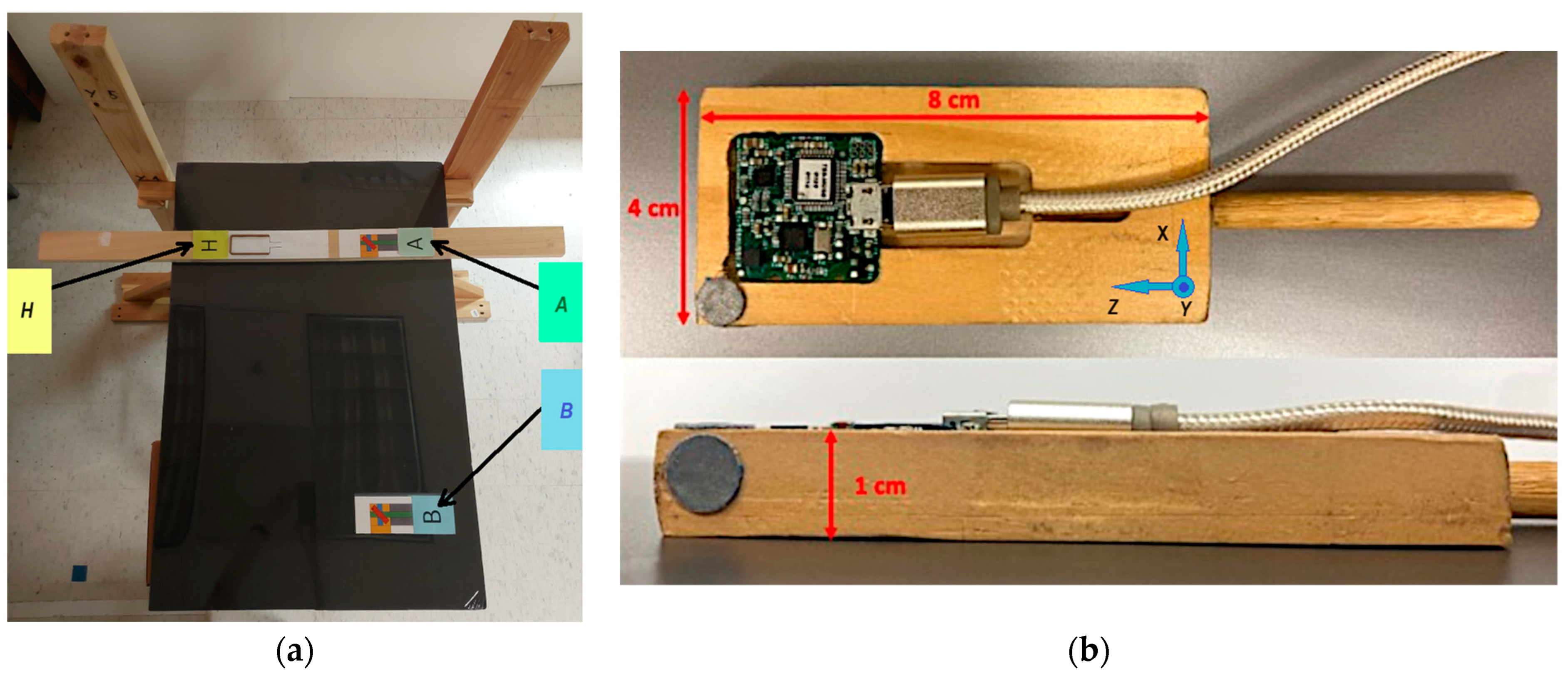
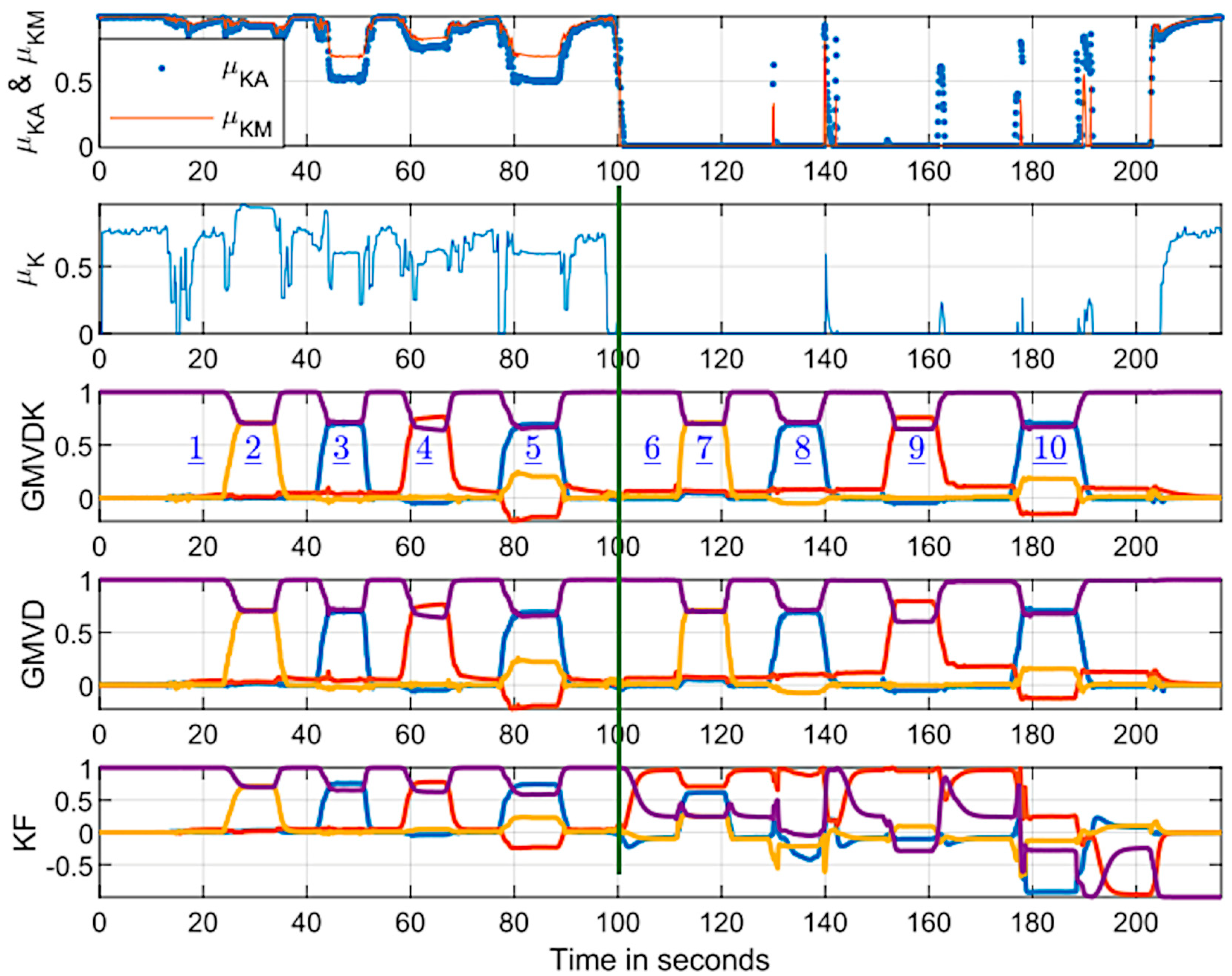
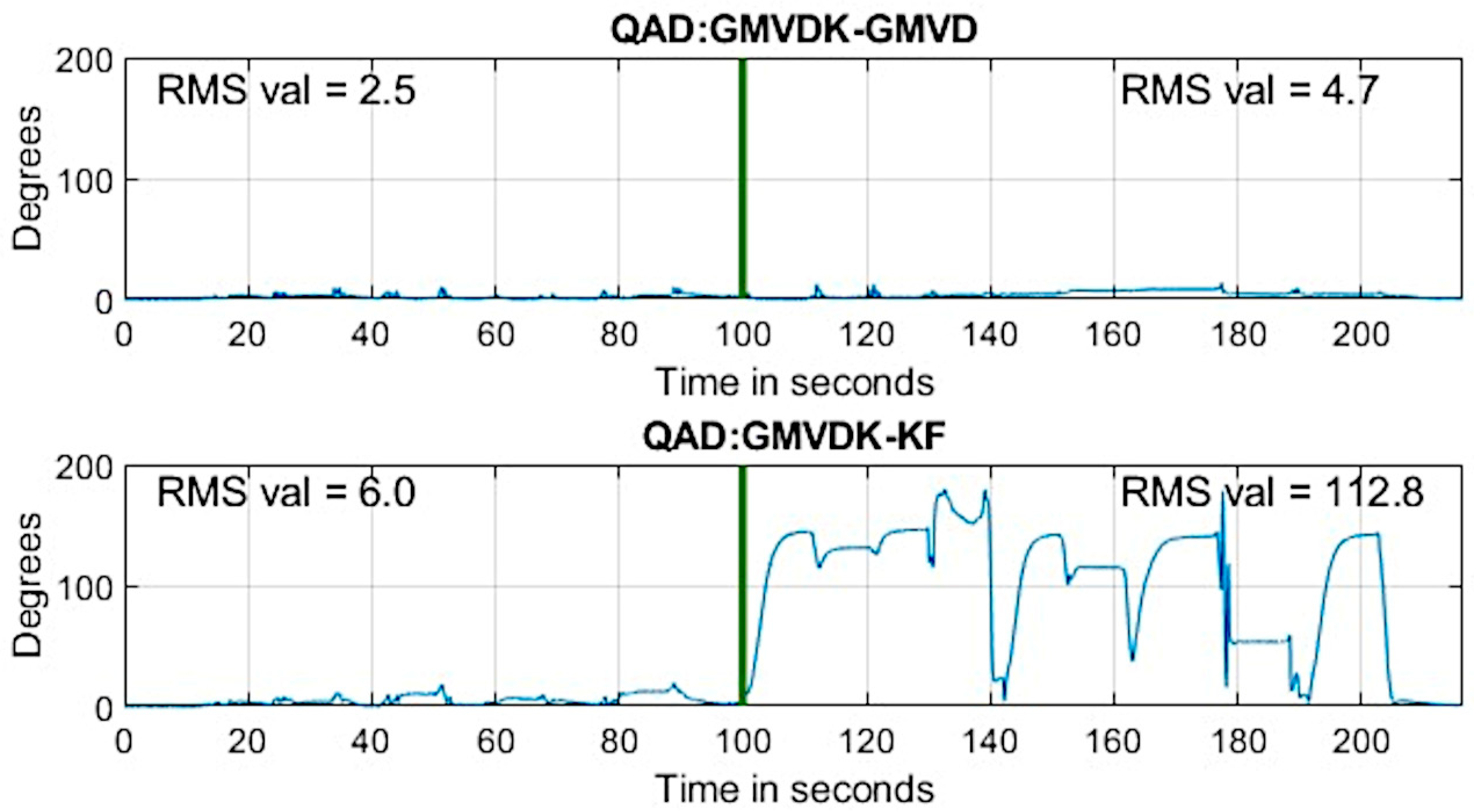
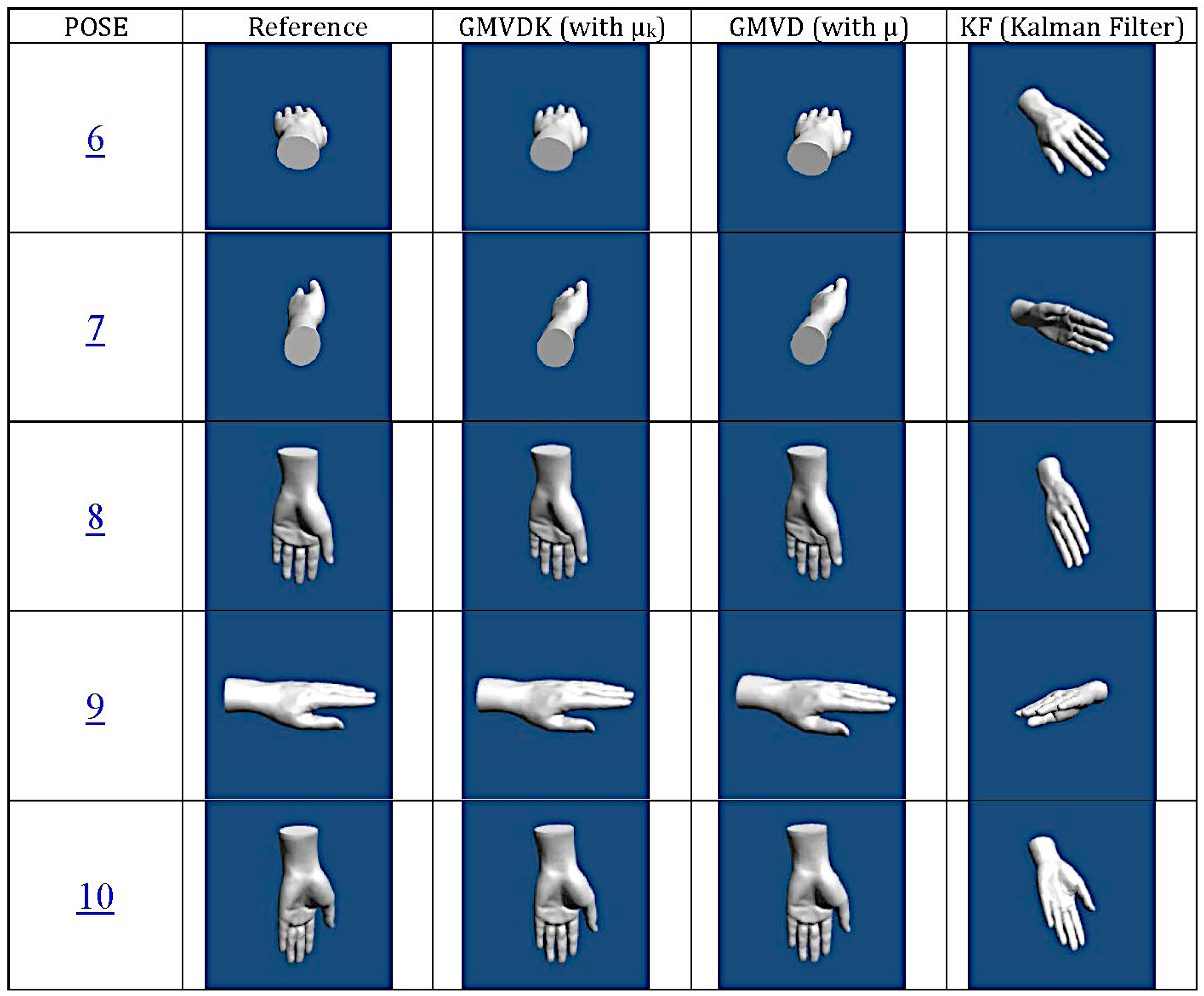

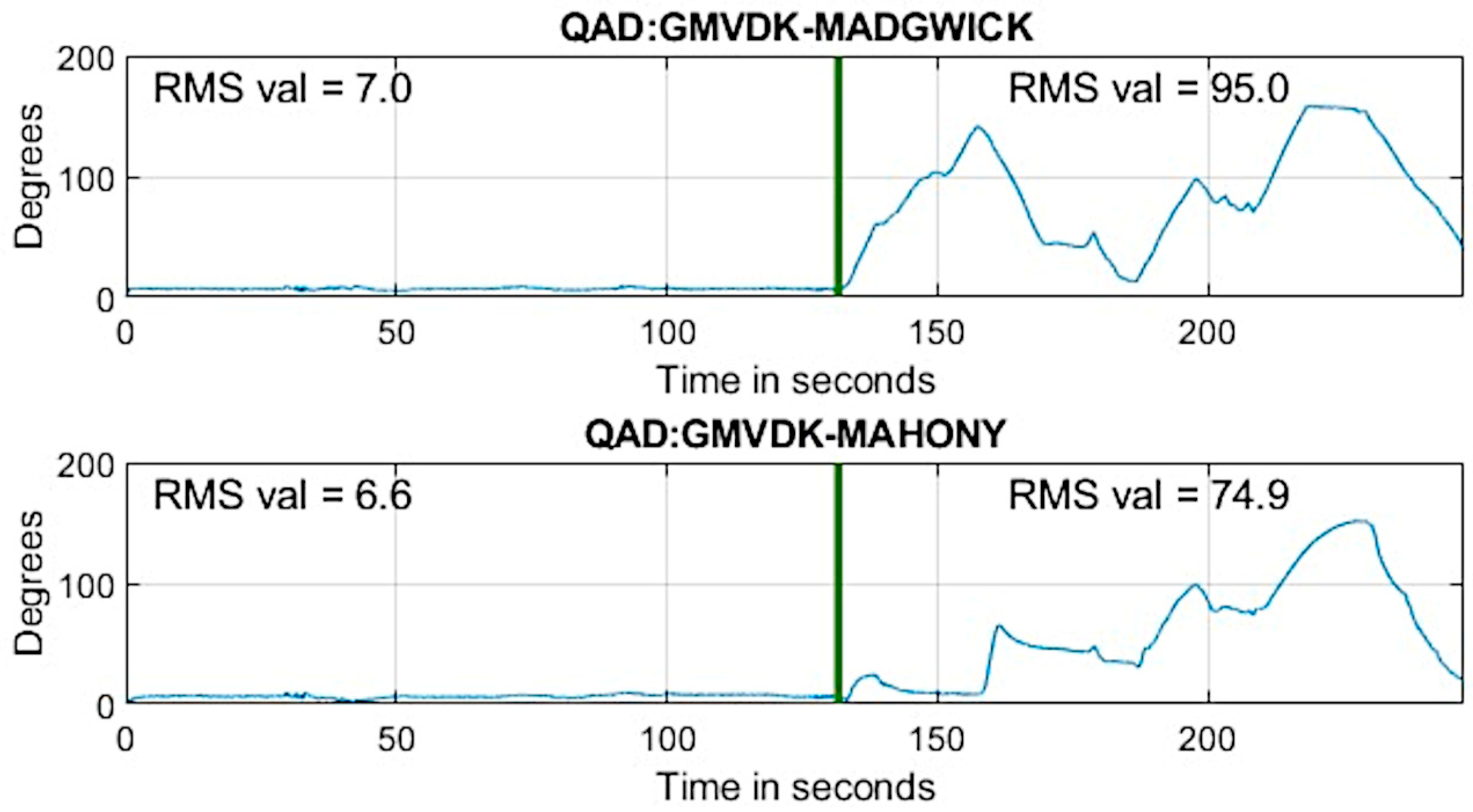
| Parameter | Commercial Grade | Tactical Grade | Navigation Grade | Strategic Grade |
|---|---|---|---|---|
| Gyro bias initial uncertainty | 150°/h | 1.5°/h | 0.0015°/h | 0.0000015°/h |
| Gyro bias stability |
| Sequence Step | Location | Rotation | Resulting Pose |
|---|---|---|---|
| 1 | H | (Initial location and pose for the task) | 1 |
| 2 | A | After translation H to A, yields | 1 |
| 3 | A | +90° Z axis, yields | 2 |
| 4 | A | −90° Z axis, yields | 1 |
| 5 | A | +90° X axis, yields | 3 |
| 6 | A | −90° X axis, yields | 1 |
| 7 | A | +90° Y axis, yields | 4 |
| 8 | A | −90° Y axis, yields | 1 |
| 9 | A | −45° Y axis and + 90° X axis, yields | 5 |
| 10 | A | −90° X axis and + 45° Y axis, yields | 1 |
| 11 | B | Just translation A to B | 6 (same orientation as 1) |
| 12 | B | +90° Z axis, yields | 7 |
| 13 | B | −90° Z axis, yields | 6 |
| 14 | B | +90°X axis, yields | 8 |
| 15 | B | −90° X axis, yields | 6 |
| 16 | B | +90° Y axis, yields | 9 |
| 17 | B | −90° Y axis, yields | 6 |
| 18 | B | −45° Y axis and + 90° X axis, yields | 10 |
| 19 | B | −90° X axis and + 45° Y axis, yields | 6 |
| 20 | H | Just translation back to H | 1 |
Disclaimer/Publisher’s Note: The statements, opinions and data contained in all publications are solely those of the individual author(s) and contributor(s) and not of MDPI and/or the editor(s). MDPI and/or the editor(s) disclaim responsibility for any injury to people or property resulting from any ideas, methods, instructions or products referred to in the content. |
© 2024 by the authors. Licensee MDPI, Basel, Switzerland. This article is an open access article distributed under the terms and conditions of the Creative Commons Attribution (CC BY) license (https://creativecommons.org/licenses/by/4.0/).
Share and Cite
Sonchan, P.; Ratchatanantakit, N.; O-Larnnithipong, N.; Adjouadi, M.; Barreto, A. Robust Orientation Estimation from MEMS Magnetic, Angular Rate, and Gravity (MARG) Modules for Human–Computer Interaction. Micromachines 2024, 15, 553. https://doi.org/10.3390/mi15040553
Sonchan P, Ratchatanantakit N, O-Larnnithipong N, Adjouadi M, Barreto A. Robust Orientation Estimation from MEMS Magnetic, Angular Rate, and Gravity (MARG) Modules for Human–Computer Interaction. Micromachines. 2024; 15(4):553. https://doi.org/10.3390/mi15040553
Chicago/Turabian StyleSonchan, Pontakorn, Neeranut Ratchatanantakit, Nonnarit O-Larnnithipong, Malek Adjouadi, and Armando Barreto. 2024. "Robust Orientation Estimation from MEMS Magnetic, Angular Rate, and Gravity (MARG) Modules for Human–Computer Interaction" Micromachines 15, no. 4: 553. https://doi.org/10.3390/mi15040553
APA StyleSonchan, P., Ratchatanantakit, N., O-Larnnithipong, N., Adjouadi, M., & Barreto, A. (2024). Robust Orientation Estimation from MEMS Magnetic, Angular Rate, and Gravity (MARG) Modules for Human–Computer Interaction. Micromachines, 15(4), 553. https://doi.org/10.3390/mi15040553









